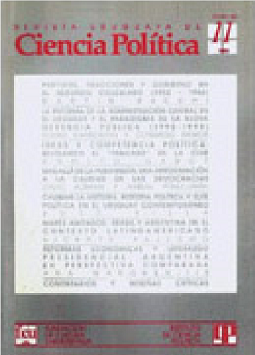Economic reforms and presidential leadership. Argentina in comparative perspective
Keywords:
Argentine, Economic reforms, GovernementAbstract
This artic1e studies the role of presidentialleadership in the economic reform process in Argentina between 1989 and 1995. Taking the presidency of Salinas de Gortari as a comparative reference, the author argues that the success in the fullfilment of the reformist goals in Argentina during the 90's, cannot be explained without considering the decisive role in the process directing carried out by President Menem. For that reason, it is essential to examine presidents' styles in order to better understand the political economy of presidential regimes.
Downloads
References
Centeno, Miguel A. (1994): Democracy within Reason. Technocratic Revolution in Mexico, University Park, Pennsylvania: The Pennsylvania State University Press, Cap. 4.
Corrales, Javier (1997-1998): "Do Economic Crises Contribute to Economic Reform? Argentina and Venezuela in the 1990s", en Political Science Quarterly, Vol. 112, # 4, Winter,
pp. 617-644.
De Riz, Liliana y Smulovitz Catalina (1991): "Instituciones y dinámica política. El presidencialismo argentino", en Nohlen, Dieter y De Riz, Liliana (comp.): Reforma institucional
y cambio político, Buenos Aires: CEDESLegasa.
Dresser, Denisse (1996): "Muerte, modernización o metamorfosis del PRI: neoliberalismo y reforma partidaria en México", en Cook, María Lorena, Kevin J. Middlebrook y Juan
Molinar Horcasitas (eds.): Las dimensiones políticas de la reestructuración económica, México, D.F.: Universidad Nacional Autónoma de México/ Aguilar, León y Cal Editores,
pp. 211-250.
Edwards III, George c., John H. Kessel, and Bert A. Rockman (eds.) (1993): Researching the Presidency, Piittsburgh, PA: University of Pittsburgh Press Greenstein, Fred 1. (ed.)
(1988): Leadership in the Modern Presidency, Cambridge and London: Harvard University Press.
EIgie, Robert, 1995: Polítical Leadership in Liberal Democracies, Houndrnills: Macmillan Press.
Ethier , Diane (1997): "Los determinantes del liderazgo político en materia de ajuste económico: lecciones del sur de Europa", en Política y Gobierno, Vol. IV, # 1, primer semestre, pp. 5-42.
Gardner, Howard (1996): Leading Minds. An Anathomy of Leadership, London: Harper Collins Publishers.
Haggard, Stephan y Kaufman Robert (1995): "Estado y reforma económica: la iniciación y consolidación de las políticas de mercado", en Desarrollo Económico, Vol. 35, # 139, Octubre- Diciembre, pp. 355-372.
Heifetz, Ronald A. and Riley M. Sinder (1990): "Political Leadership: Managing the Public's Problem Solving", en Reich, Robert B. (ed.): The PowerofPublíc Ideas, Cambridge
and London: Harvard University Press, pp. 179-204.
Heredia, Blanca (1997): "La transición al mercado en México: desempeño económico e instituciones políticas", en Cavarozzi, Marcelo (coord.): México en el desfiladero: los años de Salinas, México: Juan Pablos Editor/FLACSO, pp. 151-174.
Hernández Rodríguez, Rogelio (1998): "Presidencialismo y élite en el cambio político de México", en Política y Gobierno, Vol. V, # 1, Primer semestre, pp. 197-224.
Jones, Bryan D. (ed.) (1989): Leadership and Polítics, Kansas: University Press of Kansas. Kavanagh, Dennis (1987): Thatcherism and British Politics. The End of Consensus?,
Oxford and New York: Oxford University Press, pp. 246-247.
Llanos, Mariana y Margheritis, Ana (1999): "Liderazgo presidencial y dinámica institucional durante la primera presidencia de Menem. El caso de las privatizaciones", en Política y Gobierno, México, Vol. VI, N° 2, en prensa.
Mainwaring, Scott and Matthew Sober Shugart (eds.) (1997): Presidentialism and Democracy in LatinAmerica, Cambridge: Cambridge University Press.
Mustapic, Ana M. (1984): "Conflictos institucionales durante el primer gobierno radical: 1916-1922", en Desarrollo Económico, Vol. 24, # 93, Abril-~unio, pp. 85-109.
Mustapic,AnaM. (1997): "Las relaciones Ejecutivo- Legislativo en Argentina y Brasil", trabajo presentado en el Seminario Brasil-Argentina, organizado por el Instituto de Relaciones Internacionales de Itamaraty, Río de Janeiro, 20-21 de noviembre.
Nelson, Joan (1994): Crisis económica y políticas de ajuste, Bogotá, Colombia: Grupo Editorial Norma, Cap. 1.
Neustadt, Richard E. (1993): El poder presidencial y los presidentes modernos, Buenos Aires: Grupo Editor Latinoamericano.
Nino, Carlos (1996): "Hyperpresidentialism and Constitutional Reform in Argentina", en Lijphart, Arend and Carlos Waisman (eds.): Institutional Design in New Democracies,
Boulder, CO: Westview Press, pág. 165.
Palermo, Vicente y Novaro, Marcos (1996): Política y poder en el gobierno de Menem, Buenos Aires: Grupo Editorial Norma.
Rockman, Bert A. (1984): The Leadership Question, New York: Praeger, Cap. 6.
Serrano Carreto, Mónica (1996): "La herencia del cambio gradual. Reglas e instituciones bajo Salinas", Foro Internacional, Vol. 12, #143-144, Enero-Junio, pp. 441-468.
Sidicaro, Ricardo (1995): "Poder político, liberalismo económico y sectores populares, 1989-1995", en (autores varios): Peronismo y Menemismo. Avatares del populismo en la
Argentina, Buenos Aires: Ediciones El Cielo por Asalto, [pp. 119-156], pp. 126-129.
Skowronek, Stephen (1997): The Politics Presidents Make, Cambridge and London: The Belknap Press ofHarvard University Press.
Von Mettenheim, Kurt (1997): Presidential _ Institutions and Democratic Politics, Washing~ bn, DC: Johns Hopkins University Press.



























